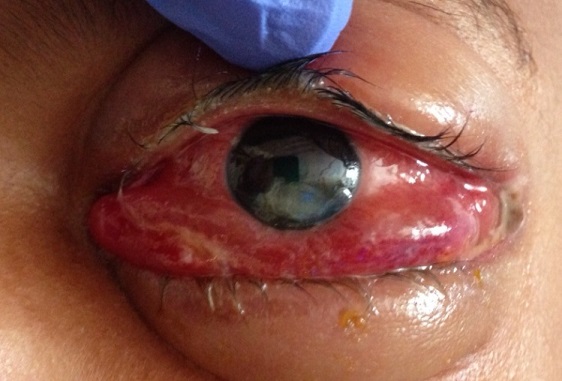Nikhil Prasad Fact checked by:Thailand Medical News Team May 20, 2025 5 months, 3 weeks, 14 hours, 27 minutes ago
Medical News: Since the start of the global pandemic, COVID-19 has been primarily recognized as a respiratory illness. However, emerging research continues to uncover its broader systemic effects, including its role in triggering or exacerbating a variety of secondary infections. One concerning complication now drawing attention in the medical community is the increased risk of orbital cellulitis—a rare but potentially life-threatening bacterial infection affecting the tissues surrounding the eye. This condition, which can lead to vision loss or spread to the brain if left untreated, appears to be occurring with greater frequency in some COVID-19 patients.
 COVID-19 Infections Increase the Risk for Orbital Cellulitis
COVID-19 Infections Increase the Risk for Orbital Cellulitis
This
Medical News report aims to explore the growing body of evidence linking COVID-19 to an increased susceptibility to orbital cellulitis, explain the underlying mechanisms, and highlight the importance of early diagnosis and treatment.
What Is Orbital Cellulitis
Orbital cellulitis is an acute infection that affects the muscles and fat within the orbit (eye socket), usually spreading from adjacent structures such as the sinuses. Common symptoms include eyelid swelling, eye pain, fever, limited eye movement, and vision impairment. Unlike preseptal cellulitis (which affects the eyelid and skin around the eye), orbital cellulitis is a more serious condition that can result in abscesses, optic nerve damage, or even intracranial complications if not treated promptly with intravenous antibiotics or surgical intervention.
Link Between COVID-19 and Orbital Cellulitis
Recent studies and case reports have documented instances where individuals infected with SARS-CoV-2—particularly those with underlying health conditions like diabetes—have developed orbital cellulitis either during or shortly after their COVID-19 illness. In a case series published in the Journal of Clinical Ophthalmology and Research, researchers described several patients who presented to hospitals with orbital cellulitis and were subsequently found to be COVID-19 positive. In many of these cases, orbital cellulitis was the initial presenting symptom, raising concerns about missed or delayed COVID-19 diagnoses.
Mechanisms Connecting COVID-19 to Increased Infection Risk
There are several hypotheses regarding how COVID-19 may increase the risk for orbital cellulitis:
-
Immune Dysregulation: SARS-CoV-2 is known to cause immune system disturbances. This dysregulation can make patients more vulnerable to bacterial superinfections, including those affecting the sinuses and orbit.
-
Sinus Involvement: The virus can affect the upper respiratory tract, leading to sinus inflammation or blockage. This may create a favorable environment for bacterial growth, which can then spread to the orbital area.
-
Medication Effects: Some treatments for severe COVID-19, such as corticoster
oids or immunomodulators, may suppress the immune response and inadvertently increase susceptibility to secondary infections.
-
Delayed Medical Care: During pandemic surges, many individuals delayed seeking treatment for sinus or respiratory issues, allowing infections to progress and spread to adjacent areas like the eye sockets.
Clinical Implications and the Need for Vigilance
Given the potential for COVID-19 to either mask or contribute to orbital cellulitis, healthcare providers must maintain a high index of suspicion, especially in patients with facial pain, swelling, or visual disturbances. This is particularly important in those with a known history of sinus disease or immunocompromising conditions such as diabetes. Prompt imaging, such as CT or MRI scans, can help determine the extent of orbital involvement, and early antibiotic treatment is critical to avoid serious complications.
Furthermore, ophthalmologists and ENT specialists are urged to consider COVID-19 testing in patients with new-onset orbital symptoms, even if respiratory signs are minimal or absent.
Conclusion
COVID-19 continues to demonstrate its ability to impact virtually every system in the human body. The observed increase in orbital cellulitis among COVID-19 patients serves as yet another reminder of the virus's capacity to complicate or exacerbate other health issues. Increased awareness, early recognition, and swift clinical response can help mitigate the risk of vision loss or other serious outcomes associated with this condition.
References
https://journals.lww.com/jcor/fulltext/2023/11010/covid_19_disease_presenting_as_orbital_cellulitis.20.aspx
https://www.mdpi.com/2076-2607/12/11/2262
https://onlinelibrary.wiley.com/doi/10.1002/lary.32252
https://journals.lww.com/jcraniofacialsurgery/abstract/2021/12000/coronavirus_disease_2019_as_a_possible_cause_of.128.aspx
https://journals.lww.com/jcor/fulltext/2023/11010/covid_19_disease_presenting_as_orbital_cellulitis.20.aspx
https://www.springermedizin.de/covid-19/combined-endophthalmitis-and-orbital-cellulitis-in-patients-with/19665636
https://publishing.rcseng.ac.uk/doi/10.1308/rcsann.2021.0306
https://www.aao.org/eye-health/news/is-covid-eye-thing
https://onlinelibrary.wiley.com/doi/10.1002/ccr3.7324
https://www.tandfonline.com/doi/full/10.1080/01676830.2020.1768560
For the latest COVID-19 News, keep on logging to Thailand
Medical News.
Read Also:
https://www.thailandmedical.news/news/breaking-covid-19-news-study-claims-that-omicron-infections-can-lead-to-acute-primary-angle-closure-and-also-primary-angle-closure-glaucoma
https://www.thailandmedical.news/news/breaking-covid-19-news-chinese-study-discovers-that-sars-cov-2-increases-the-risk-for-developing-acute-angle-closure-glaucoma
https://www.thailandmedical.news/news/sars-cov-2-also-targets-the-nervous-system-of-eyes-causing-ocular-neuroinflammation
https://www.thailandmedical.news/articles/coronavirus
https://www.thailandmedical.news/pages/thailand_doctors_listings
